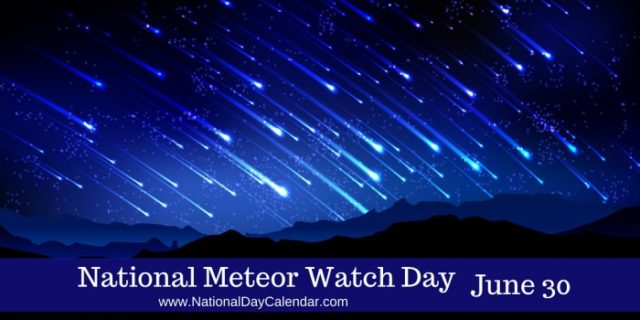
National Meteor Watch Day is observed every year on June 30th. Also known as National Meteor Day, on a cloudless night, people turn their eyes to the heavens in hopes of spotting the glow of a falling or shooting star.
A list of meteor shower dates as well as a guOide to successful watching can be found on the EarthSky website.
When space debris, such as pieces of rock, enter the earth’s atmosphere the friction causes the surrounding air to become scorching hot. This “shooting star” streaking through the sky surrounded by flaming hot air is a meteor.
Legend has it that if you wished upon a shooting star the wish would come true. It is believed to have originated in Greece, when a Greek astronomer Ptolemy, around AD 127-151, wrote that the Gods occasionally, out of curiosity, peer down at the Earth from between the spheres. When this happened stars sometimes slip through the gap, becoming visible as shooting stars. It was thought that because the Gods were already looking at us, they would be more receptive to any wishes we made!
Meteors sometimes occur in showers. National Meteor Watch Day is an excellent time to plan for a meteor watching party. Whether it is to catch a few stray falling stars or to watch an entire meteor shower, gathering the kids or a few friends to map the constellations while waiting to make a wish or two is sure to be a fun time.
The majority of the meteoroids that cause meteors are only the size of a pebble.
In the Northern Hemisphere, one of the most active meteor showers is the Perseids. Named after the constellation Perseus where the majority of the activity takes place, the meteors are caused by particles released by the comet 109P/Swift-Tuttle. Active from mid-July to late August, the Perseids are known to put on a dazzling display at its peak, especially when the skies are clear and the moon is new.
Meteors are usually observed at night and are visible when they are about 34 to 70 miles above the Earth, and they often disintegrated at about 31 to 51 miles above. Their glow time is usually about a second.
A small percent of meteoroids hit the Earth’s atmosphere and then skip back into space.
The chemical composition and the speed of the meteoroid will cause different hues to the light. Possible colors and elements producing them include:
- Orange/yellow (sodium)
- Yellow (iron)
- Blue/green (copper)
- Purple (potassium)
- Red (silicate)
Facts about meteors
- A meteor shower occurs when the Earth passes through the trail of debris left by a comet or asteroid.
- Meteors are bits of rocks and ice ejected from comets as they move in their orbits about the sun.
- A meteor that reaches the ground it is called a meteorite.
- Comets continuously eject material with each passage around the sun; this replenishes the shower meteoroids.
- Approximately 30 meteor showers occur each year that are visible to observers on Earth. Some of these showers have been around longer than 100 years. For example, the Perseid meteor shower, which occurs each year in August, was first observed about 2000 years ago and recorded in the Chinese annals.
- A fireball is a meteor that is brighter than the planet Venus.
- Radar indicates there are 12,000 meteors on a given night that are about the size of a piece of dust.
- The International Space Station has shielding to protect it from meteors up to an inch wide.
Sources:












